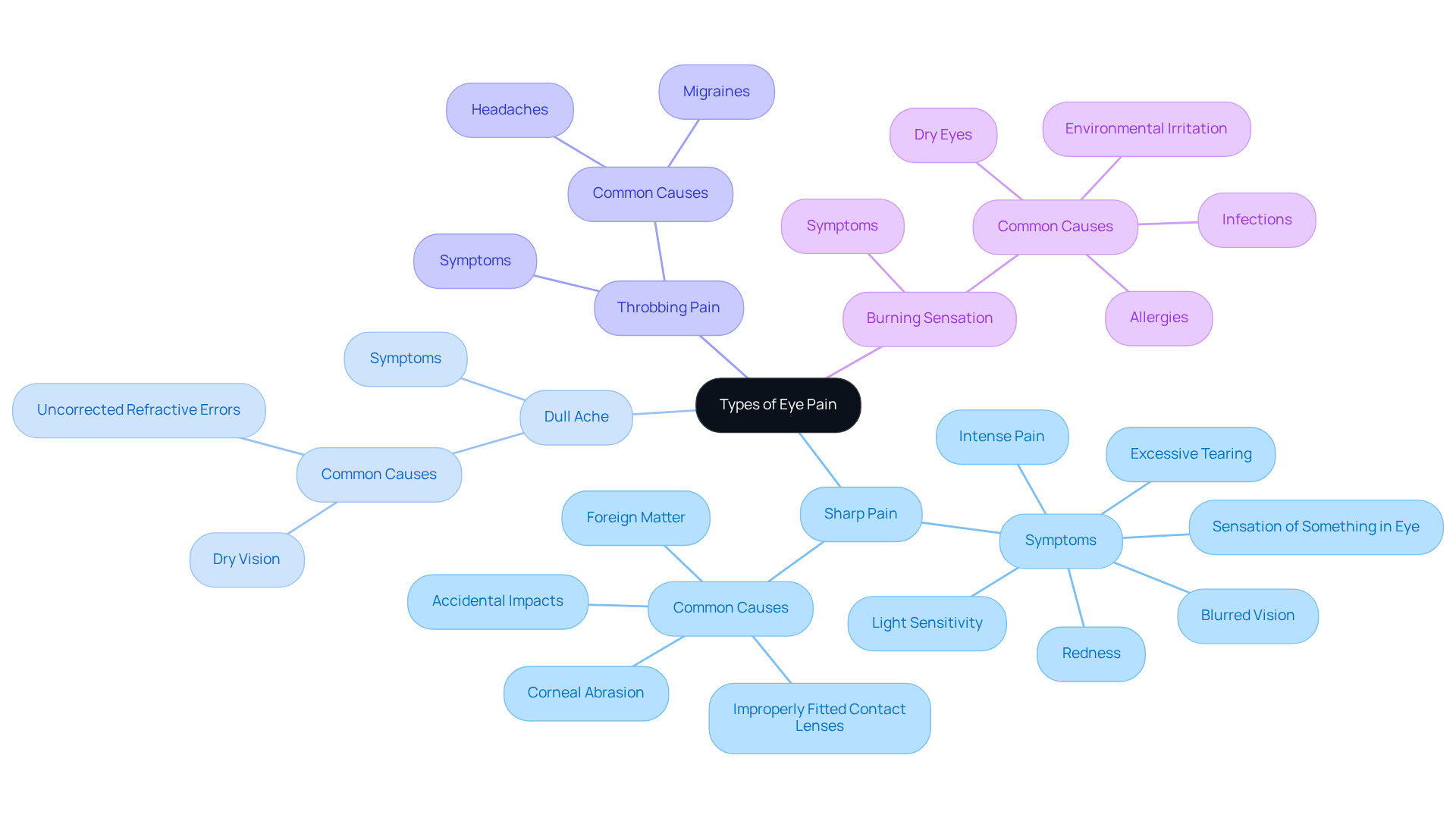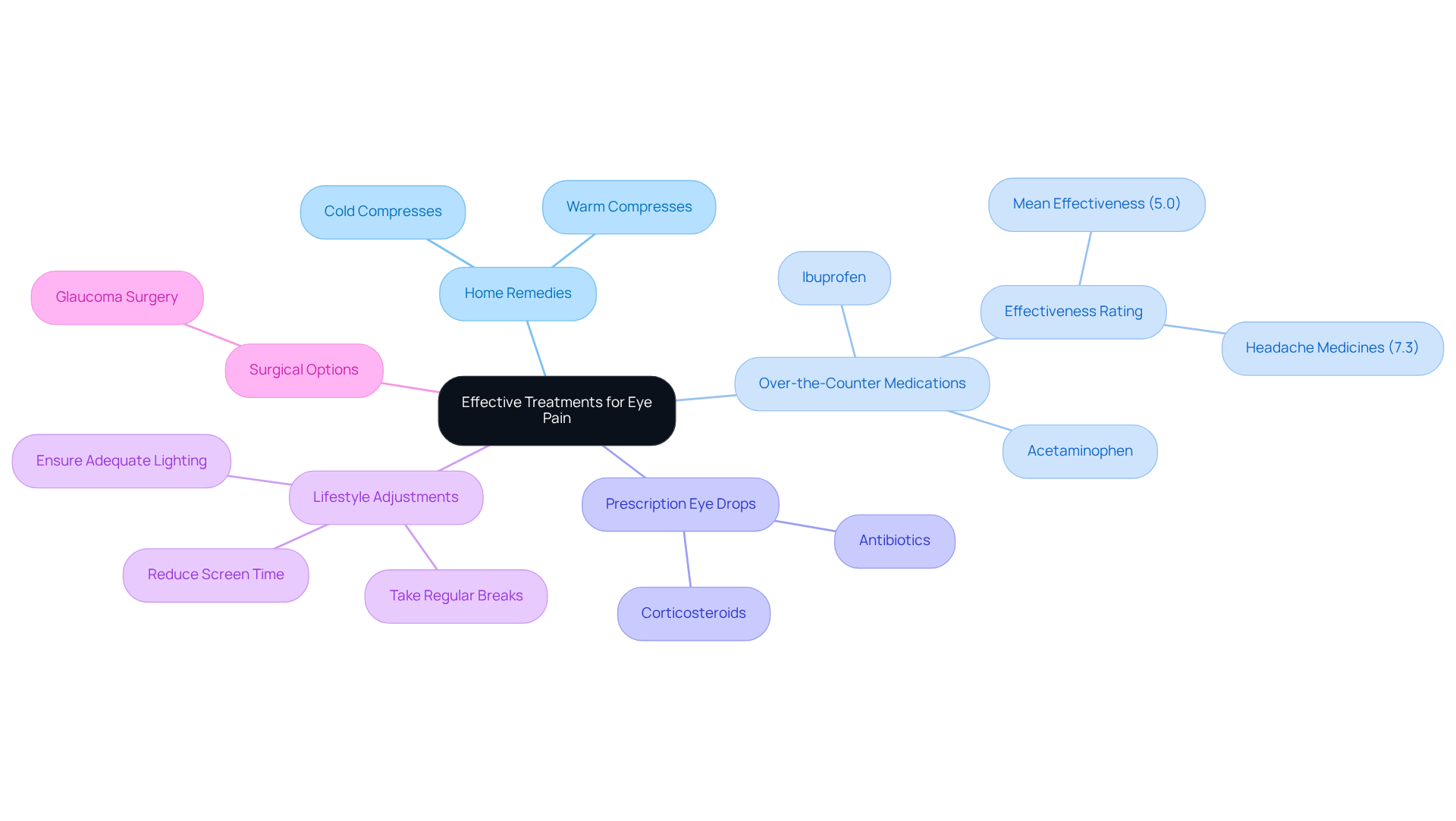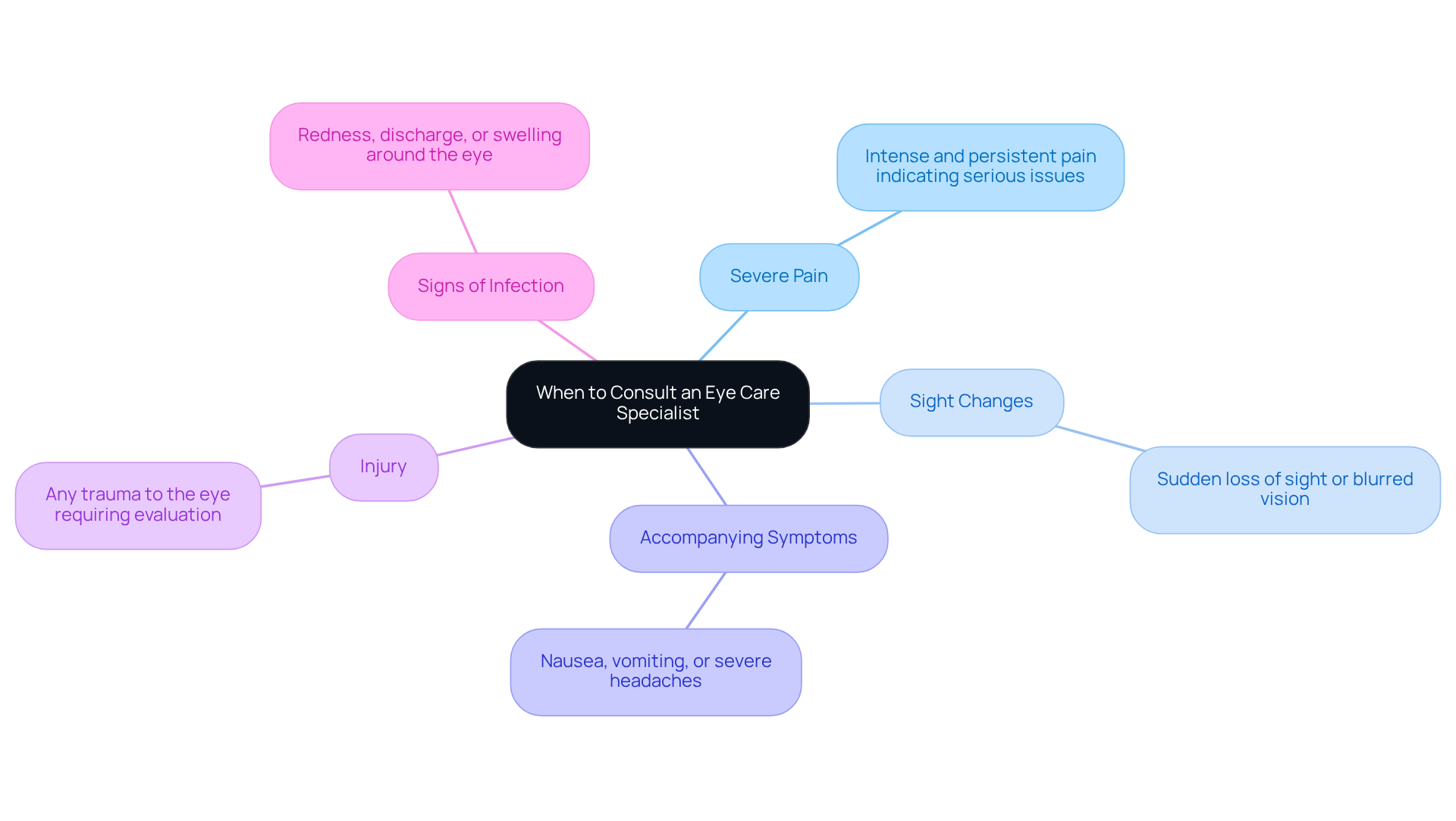Posted by: Northwest Eye in General on November 18, 2025
Introduction
Experiencing pain in your left eyeball can be both perplexing and distressing. We understand that this discomfort often leaves you searching for answers and relief. By recognizing the different types of eye pain – ranging from sharp, throbbing sensations to dull aches – you can better identify potential causes and seek appropriate treatments.
However, it’s common to feel uncertain about when discomfort signals a serious issue that requires professional intervention. What signs should you look for that indicate it’s time to consult an eye care specialist? And how can you effectively manage and alleviate this discomfort?
We are here to help you through this process, providing the support and information you need to navigate your concerns.
Explore the Nature of Eye Pain
Left eyeball pain can manifest in various forms, and we understand how concerning this can be. Here are some common types:
-
Sharp Pain: This often indicates an injury or acute condition, such as a corneal abrasion, which is a scratch on the surface of the cornea. Symptoms may include intense left eyeball pain, a sensation of something in the eye, excessive tearing, redness, light sensitivity, and blurred vision. Common causes include accidental impacts from fingernails, makeup brushes, or foreign matter like dirt and dust, as well as improperly fitted contact lenses.
-
Dull Ache: This may suggest persistent problems or strain, possibly linked to conditions like dry vision or uncorrected refractive errors.
-
Throbbing Pain: This could be associated with headaches or migraines, which can also impact your vision.
-
Burning Sensation: Often related to dry eyes or allergies, but it may also indicate irritation from environmental factors or infections.
Understanding these differences is crucial for assessing the seriousness and potential sources of your left eyeball pain. If you experience symptoms like those of a corneal abrasion, we encourage you to consult a Northwest Eye doctor for an accurate diagnosis and appropriate treatment. Remember, we are here to help you through this process.

Identify Common Causes of Left Eyeball Pain
Experiencing left eyeball pain can be concerning, and it’s important to understand what might be causing it. Here are some common causes:
- Eye Strain: This often happens after long hours in front of a screen or while reading. We understand that this can lead to discomfort and fatigue.
- Infections: Conditions like conjunctivitis or keratitis can cause significant irritation. If you notice redness or discharge, it’s best to consult a healthcare professional.
- Glaucoma: Elevated pressure in the eye can lead to intense discomfort. It’s common to feel anxious about left eyeball pain, but early detection is key.
- Optic Neuritis: This inflammation of the optic nerve is often linked to multiple sclerosis. If you’re experiencing vision changes, please seek medical advice.
- Sinusitis: Inflammation of the sinuses can sometimes cause referred pain in the eye. It’s not unusual to feel this discomfort, especially during allergy seasons.
Recognizing these causes is the first step towards seeking timely medical intervention. Remember, we are here to help you through this process and ensure you receive the care you need.

Implement Effective Treatments for Eye Pain
Effective treatments for eye pain encompass a variety of approaches that can help you feel better:
- Home Remedies: We understand that irritation can be uncomfortable. Utilizing warm compresses can soothe your eyes, while cold compresses are effective for reducing swelling.
- Over-the-Counter Medications: Pain relievers like ibuprofen and acetaminophen are commonly used to alleviate discomfort. Many users find these medications effective, with headache medicines scoring an effectiveness rating of 7.3 on a 10-point scale. The mean effectiveness score for all five OTC products is 5.0, showing that you’re not alone in seeking relief.
- Prescription Eye Drops: If you’re dealing with infections or inflammation, eye care specialists may prescribe specific drops that target the underlying issues. Commonly prescribed drops may include corticosteroids for inflammation or antibiotics for infections, providing you with the care you need.
- Lifestyle Adjustments: Lifestyle adjustments are essential because it’s common to experience left eyeball pain, particularly due to our screen-heavy lives. To help prevent discomfort, including left eyeball pain, reducing screen time, ensuring adequate lighting, and taking regular breaks can promote better eye health.
- Surgical Options: In severe cases, such as glaucoma, surgical intervention may be necessary to maintain sight. We know this can be daunting, but it’s important to address these issues promptly.
Consulting with a healthcare provider is essential to determine the most appropriate treatment plan tailored to your individual needs. This ensures that any underlying conditions are addressed effectively, promoting optimal eye health. As highlighted by the American Academy of Ophthalmology, untreated eye conditions can lead to serious complications, including permanent loss of sight. Remember, we are here to help you through this process.

Recognize When to Consult an Eye Care Specialist
If you’re experiencing any of the following, it’s important to consult an eye care specialist:
- Severe Pain: Intense and persistent pain can indicate a serious underlying issue that requires immediate attention. We understand how distressing this can be, and it’s crucial to address it promptly.
- Sight Changes: Sudden loss of sight or blurred vision are critical symptoms that necessitate prompt evaluation. Blurred vision, which may stem from conditions like cataracts or diabetic retinopathy, can signal the presence of eye disease. Please don’t ignore these signs; your vision is precious.
- Accompanying Symptoms: If you’re experiencing nausea, vomiting, or severe headaches alongside discomfort in your eyes, these symptoms should not be overlooked. It’s common to feel anxious in such situations, especially if you are experiencing left eyeball pain, but seeking help is the best step forward.
- Injury: Any trauma to the eye, no matter how minor it seems, should be evaluated immediately to prevent complications. Remember, it’s always better to be safe than sorry.
- Signs of Infection: Redness, discharge, or swelling around the eye can indicate an infection that requires urgent care. We’re here to help you navigate these concerns.
Prompt consultation can prevent further complications and ensure you receive the appropriate treatment. Did you know that eye discomfort accounts for over five million healthcare visits each year in the U.S.? Many of these instances are non-vision threatening, but early intervention is essential. In fact, 89.4% of initial visits for eye discomfort lead to a scheduled follow-up, highlighting the importance of addressing symptoms early. Real-life examples show that severe left eyeball pain often necessitates specialist consultations, underscoring the need for awareness of these critical signs. We are here to help you through this process.

Conclusion
Experiencing pain in your left eyeball can be distressing, and it’s completely understandable to feel concerned. By understanding the different forms, causes, and treatments of this pain, you can take empowered steps toward seeking the right care. This article has explored the nature of eye pain, highlighting:
- Sharp sensations
- Dull sensations
- Throbbing sensations
- Burning sensations
Each pointing to different underlying issues. Recognizing these sensations is crucial for determining how serious the condition might be and what responses are appropriate.
We understand that common causes like:
- Eye strain
- Infections
- Glaucoma
- Sinusitis
can lead to discomfort. Effective treatments can range from home remedies and over-the-counter medications to lifestyle adjustments and, in more severe cases, surgical options. It’s important to consult an eye care specialist, especially if you’re experiencing severe pain, changes in your sight, or signs of infection. Early intervention can prevent complications and protect your vision.
Ultimately, being aware of and proactively managing left eyeball pain is essential. Don’t hesitate to seek professional help when symptoms arise; timely action can significantly impact your eye health. By staying informed and attentive to the signs of ocular discomfort, you can ensure better outcomes and maintain your overall well-being. Remember, we are here to help you through this process.
Frequently Asked Questions
What are the common types of left eyeball pain?
Common types of left eyeball pain include sharp pain, dull ache, throbbing pain, and burning sensation.
What does sharp pain in the left eyeball indicate?
Sharp pain often indicates an injury or acute condition, such as a corneal abrasion. Symptoms may include intense pain, a sensation of something in the eye, excessive tearing, redness, light sensitivity, and blurred vision.
What are some causes of sharp pain in the left eyeball?
Causes of sharp pain can include accidental impacts from fingernails, makeup brushes, foreign matter like dirt and dust, and improperly fitted contact lenses.
What does a dull ache in the left eyeball suggest?
A dull ache may suggest persistent problems or strain, possibly linked to conditions like dry vision or uncorrected refractive errors.
What is throbbing pain in the left eyeball associated with?
Throbbing pain could be associated with headaches or migraines, which can also impact vision.
What might a burning sensation in the left eyeball indicate?
A burning sensation is often related to dry eyes or allergies, but it may also indicate irritation from environmental factors or infections.
When should I consult a doctor about left eyeball pain?
You should consult a doctor, especially if you experience symptoms like those of a corneal abrasion, for an accurate diagnosis and appropriate treatment.






